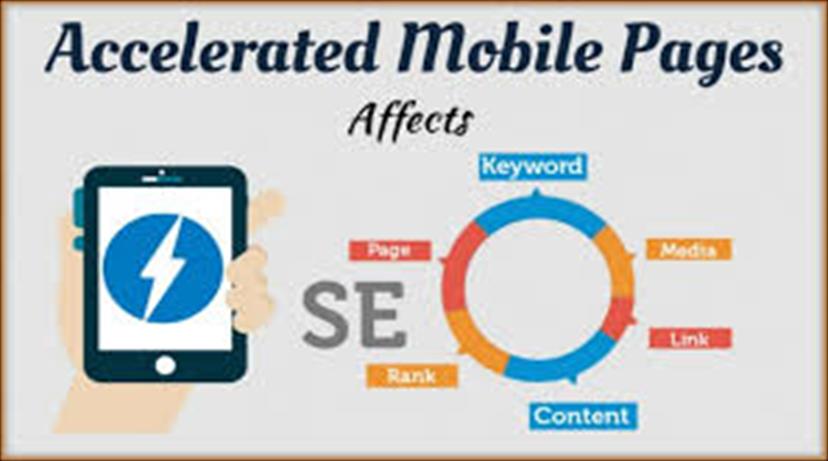One of the best company to work and IT solutions. Delivered product quickly and very fast. It was really mice working with them. I will give them move orders.
- Whatsapp Chat
- Telegram Chat
- Email: info@tritansolutions.com
- Skype:
- Login / Register
The Definitive Guide to Accelerated Mobile Pages AMP in 2021
In simple terms, Accelerated Mobile Pages is an open-source initiative project designed to optimize faster mobile pages.

According to 2021 research, mobile traffic has risen at 4% in daily media consumption since 2020. With more and more customers utilizing their mobile phones to access content, it's more significant than ever to optimize for the mobile experience—not just for your audience, but your SEO; Google can inspect pages that load deliberately slow or that have a huge bounce rate and will index those pages lower in search results.
Are you wondering what the advantages of AMP for your business and whether it’s worth using it? Well, don't worry, in today's blog, we will explain you in detail. AMP is an open-source initiative that strives to enhance the web browsing experience by diminishing page loading times. While rapid web browsing is stimulating, it’s not the only motive why website owners are creating their mobile pages in the stripped-down format. More windfalls indicate AMP will have a primary impact on the prospect of website publishing.
Before we deep dive in if you need to understand more about the details of AMP, check out our latest blog, What Is AMP? In the blog post, we will elucidate in greater detail what AMP is and its potential significances for publishers and website owners.
Let’s take a glimpse at the extra windfalls that AMP gives website owners and investigate some case studies that have utilized AMP to incredible success.
1. Huge Growth in Traffic and SEO Ranking
One of the best ways site owners can entice additional traffic is to enhance the browsing experience, and AMP’s focus on portable content does just that. Moreover, AMP’s set of standards enables site owners to decrease page load time, and in performing so, they boost the user experience and boost the possibility of visitors staying on-site for longer durations.
Page load time moreover plays a huge role in SEO, and since this endeavor is being initiated by Google, AMP pages are prioritized in their search algorithms and have an optimistic influence on search engine results pages (SERP). If two sites rank likewise when it comes to SEO, the one with the most speed gets preference.
2. Low Bounce Rate and More Time On-Site
Quickly loading pages boost the possibility that your visitors will stay on your pages longer time because the experience is quick and straightforward. According to a Google survey, 53 percent of website visits are withdrawn if a mobile site takes longer than 2-3 seconds to load. Publishers who execute AMP should glimpse a decreased bounce rate, and potentially a 2x rise in time spent on a page.
3. The Potential for Increased Ad Views
In AMP, the HTML is coded in a manner to strengthen the overall usability of banners and pictures. This implies that there should be an increased ad viewability rate, which can enable brands to monetize their sites.
4. Being Featured on the Google Search Top Stories Carousel Leads to a Higher Click-Through Rate (CTR)
One of the considerable advantages of AMP is that it exhibits pages on the Google Search Top Stories carousel. When users search for content on their mobile devices, the carousel arises at the top of all searches, enabling them to click this content initially. Not only does the carousel help website owners with AMP pages because their content is featured initially, but it moreover facilitates non-AMP owners to concentrate on developing pages that are mobile-friendly for customers.
• Is AMP necessary?
Before we get into the advantages and disadvantages of Google AMP, it's vital to note that while AMP can boost your SEO, it is not inevitably crucial for SEO in some cases, and the benefits are more applicable to some businesses than others. We will do an intense dive into the pros and cons of AMP next, but let’s first just give some pivotal points that can boost you to orient yourself to AMP as it associates with your company :
1) AMP is widely acquired by publisher sites that have a huge volume of news articles or blog posts. If the majority of your website pages aren’t blogs, articles, then AMP may not be essential for your corporation.
2) If you do publish a huge quantity of articles but are already utilizing a CDN (content delivery network), these platforms frequently appear with performance optimization features such as picture hosting, file caching, and inactive loading (which implies the text loads first, before the pictures ).
3) AMP pages are neater and modest for readers, but frequently because certain JavaScript functions and plugins are deprioritized or quelled. If you depend on third-party tools for lead capturing and audience tracking, you’ll need to test to make certain your AMP pages function and apprehend data in the same way as your normal pages.
4) AMP itself is not a Google ranking characteristic. It can enable you to enhance aspects of your web pages that are inbuilt into Google’s algorithm (particularly with Core Web Vitals becoming a ranking factor in 2021), but it is not the manner to optimize your site’s experience and execution.
5) If you already have a mobile version of your site or mobile optimization estimates in place (such as compact or minified CSS code), AMP may not be crucial for your organization and may even confuse execution and reporting of your website.
6) While AMP can boost your SEO, it is not inescapably vital for SEO, and its advantages are more favorable to some companies than others.
7) So the bottom line is, optimizing for page speed and mobile experience is necessary for SEO, and Google AMP is only one way of accomplishing that. Let's examine and learn about how it functions and whether it’s a favorable solution for your business.

• What are the advantages of Google AMP?
Apart from rapidly loading speeds and a promising experience for content customers, AMP gives several advantages to companies with a content and SEO technique -
• Increased website engagement
Portable AMP content fuses nicely with mobile users that have a less-than-stable internet connection. Besides, the decline in page load time enhances the user experience in a manner that enhances the possibilities of visitors to remain on your site longer.
• Superior ranking and traffic
Also, with page load time being a major Google ranking aspect, AMPs are prioritized in Google’s search algorithms, therefore influencing rankings. Practically, if 2 sites are in neck-to-neck competition, the prompt website will win out.
• Lower bounce rates
With your pages loading rapidly, visitors usually remain on your website. A Google survey once found that 73% of website visits are abandoned if a mobile site takes longer than 2-3 seconds to load. Besides this, publishers who execute AMP could potentially get a 2x boost in time spent on a page. And extra time on your website can suggest more discussions, likes, comments on your site content.

• Enhanced ad views
With AMP, the HTML is coded in a manner that improves the all-around usability of banners and pictures. This results in an increased ad viewability rate, enabling publishers to boost probabilities for monetizing their website content.
• Higher click-through rates
A crucial advantage of AMP is that it is shown in the trending Stories list (or carousel) of the Google mobile SERP—which occurs on top of all search results. Readers are highly more plausible to choose those AMP pages first, leading to boosted click-through rates.
• Current AMP statistics
While many prominent websites are utilizing AMP technology today, such as Yahoo, CNN, BBC, Reddit, Washington Post, WordPress, Gizmodo, Wired, Independent.co.uk, Pinterest, eBay, and many more, it is not a technology devoted only to big brands. AMP technology is being utilized by over 11.4 million websites. The data below demonstrates which enterprises are utilizing AMP the most:
1) Computer Electronics & Technology accounts for about 6%.
2) Science & Education is close behind at 5.88%.
3) Gaming accounts for about 5.15% of AMP technology usage.
4) Arts & Entertainment accounts for almost 11% of total AMP technology usage.
• AMP HTML
AMP HTML differs from normal HTML (or HTML5) in that it appears with mobile-focused properties and custom tags. AMP HTML ensures specific baseline performance characteristics, which translates to content loading quickly on users’ devices. This suggests that faster consumption by the reader and a promising overall user experience, which can influence conversion rates and SEO/content marketing metrics like bounce rate (spoken of above) and time on site. (Faster consumption suggests the reader can consume extra articles in less time).
Because all global traffic comes from smartphones and tablets, the significance of a good-looking website on a mobile device is unavoidable. However, it is risky to cover all categories of mobile screen resolutions and internet formats with a single solution. Luckily, such businesses as Google always put user experience mainly, giving such open source solutions as AMPs (Accelerated Mobile Pages).
• What Is an AMP?
Google AMP is an open-source technology directed at giving a fast-loading mobile website experience with a typical page-loading time calculated at less than 1 second. The project was developed for websites concentrated on delivering content for ‘reading’ news.
• How Does an AMP functions?
To give a rapid and steady browsing experience, AMP pages take benefit of HTML, JavaScript, and CSS lightweight versions. In different words, AMP technologies are utilized with some regulations to assure near-instant page load times and website compliance to AMP specifications.
• In addition to optimizing the code, AMP standards enable you inn accomplishing much faster page loading speed through:
1) Utilization of caching;
2) Prioritizing the content loading above the fold;
3) Parallel loading of elements and scripts;
4) Partial preload of pages that are plausible to be clicked on.
5) Although it might seem AMP is a ‘panacea’ for a tremendous mobile website experience, it has both benefits and flaws.
• AMP windfalls and hitches too.
Honestly speaking, there are multiple AMP windfalls as AMP complications. So here are the main pros and cons of utilizing this website publishing technology.
• When AMP- Your Website?
As you can glimpse, AMP is not an extensive solution. It is nicely fitted for companies with static content. So it is no wonder that the promising AMP examples are almost completely made up of news publishing sites, including British financial and business TV station CNBC, American newspaper The Washington Post, technology journalism portal The Verge, British newspaper The Guardian, and more.

Conclusion -
As you’ve understood in the blog, AMP is a great way to speed up web pages, eventually, giving incredible UX in your content delivery, extremely for mobile users. If, based on your business prototype and the criteria above, it is considered right for your corporation, be certain to take the above reflections into account and follow the steps for execution. It may take some time, but maintaining better-performing content gives long-term advantages.
Although AMP is a contemporary IT trend, company owners have to keep in mind noticeable disadvantages specific to any AMP website. So when it comes to concerns like whether your website requires AMP or not, the straight reply is: it depends.







